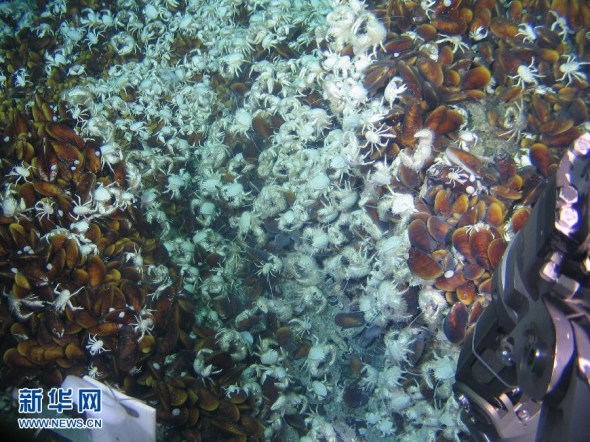

High-definition video images acquired by Chinese submersible Jiaolong show brown mussels dotting the area around the cold vent some 1,500 meters under water during its manned dive mission in the South China Sea, scientists said Tuesday.(Xinhua Photo)
High-definition video images acquired by Chinese submersible Jiaolong show brown mussels dotting the area around the cold vent some 1,500 meters under water during its manned dive mission in the South China Sea, scientists said Tuesday.
Zhou Huaiyang, professor of the School of Marine and Earth Science at Tongji University, became the first scientist to work on the sub as a crew member during a dive conducted on Tuesday.
Zhou said the quality of the images obtained during the dive is the best ever achieved in extreme oceanic conditions using domestically produced equipment.
"The discovery of multiple sea bed dwellers, such as mussels and pilumnus crabs, will help to support further research concerning the deep-sea biosphere, gas hydrate resources and climate change," Zhou said.
A cold vent is an area of the ocean floor where hydrogen sulfide, methane and hydrocarbon-rich fluid seepage occurs, according to Feng Dong, a researcher from the South China Sea Oceanic Institute under the China Academy of Social Science.
"Cold vents are a current focus in scientific circles, as they can give us information on potential gas hydrogen resources, climate change and extremophilic organisms," Feng said.
The Jiaolong's cold vent samples will help support research on deep-sea biospheres, according to Feng.
Scientists have described the Jiaolong manned deep-sea submersible's role in oceanic research as being of great significance following Monday's commencement of a four-month trial mission.
The submersible also completed a deep-sea dive in the South China Sea on Monday. It was unloaded from the Xiangyanghong 09 oceanographic vessel and began its dive around 10 a.m., returning to the vessel around 4:30 p.m. The submersible and its crew of three dove to a depth of about 1,400 meters during the dive.
The crew included Ye Cong, chief designer of the Jiaolong and an employee of the China Shipbuilding Industry Corp., Yang Bo, a researcher from the Institute of Acoustics under Chinese Academy of Sciences (CAS) and Liu Kaizhou from the Shenyang Institute of Automation under the CAS.
Liu Feng, chief commander of the mission, said the success of the dive confirmed the submersible's ability to perform reliably.
"We arrived at a sea bed located at a depth of 1,400 meters, then moved uphill until we found a cold vent," said Ye, who also piloted the craft.
The Jiaolong has an edge in accurate sampling, as its mechanical arms enable it to collect samples more precisely, said Yang Qunhui, a professor from Tongji University.
"We expect that the Jiaolong can be used to cultivate biological samples on the sea bed, as the high pressure and temperature of the deep sea make it an ideal environment for in-situ cultivation," Yang said.
In June last year, the submersible set a new dive record after reaching a depth of 7,062 meters in the Pacific Ocean's Mariana Trench. The current mission marks the start of a five-year trial period for the Jiaolong before it goes into regular operation.
The submersible left the city of Jiangyin in east China on Monday to begin a 113-day-long mission that will include experiments designed to test its positioning system, as well as biological surveys and geological sampling to be conducted in the Pacific Ocean.
Jiaolong completes dive in South China Sea
2013-06-18Jiaolong prepares to dive into South China Sea
2013-06-18Jiaolong research team starts work
2013-06-14Copyright ©1999-2018
Chinanews.com. All rights reserved.
Reproduction in whole or in part without permission is prohibited.